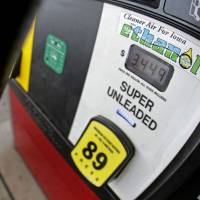When it comes to ethanol, the United States may have reached its limit — at least for now.
In 2007, Congress passed a law that would require the nation to use more ethanol and other biofuels each year. But for reasons of chemistry and economics, those targets are becoming increasingly difficult to fulfill.
That helps explain why, on Friday, the Environmental Protection Agency took the unusual step of proposing to cut its biofuel targets for next year. The agency will require gasoline refiners to use 15.2 billion gallons (57.5 billion liters) of biofuels in 2014 — down from 16.5 billion gallons this year.
The EPA's move is a victory for gasoline refineries, which long argued that the targets were unworkable. And it is a fairly big setback for the biofuel industry, at least for the time being.
Here is the back story: In 2007, Congress updated its Renewable Fuel Standard, which set rough targets for the amount of ethanol and other biofuels that had to be blended into the nation's gasoline supply each year. By 2013, that target rose to 16.5 billion gallons — and it was supposed to keep rising until it hit 36 billion gallons in 2022.
There was just one hitch. When Congress passed the law in 2007, lawmakers figured that Americans would keep using more and more gasoline each year, and all that ethanol would make up a small portion of the total. Instead, the opposite happened. Americans started buying more fuel-efficient cars and driving less. U.S. gasoline use has actually fallen in recent years.
And that created a hassle. Right now, the nation is at the point where much of its gasoline contains about 10 percent ethanol. That, in itself, is not a problem. Cars and fuel pumps in the United States can easily handle gasoline with 10 percent ethanol or less, a blend known as E10. But mixing even more ethanol in that gasoline — say, moving up to 15 percent, or E15 — makes things trickier.
E15 is more corrosive, and it is not deemed suitable for cars built before 2000, heavy-duty vehicles, motorcycles or nonroad engines such as those in boats or snowmobiles. For cars built after 2001, the government has declared the fuel safe after extensive testing, but even so, many auto manufacturers have said that their warranties will not cover any damage caused by fueling with E15.
For that reason, the 10 percent number is known as the "blend wall," and fuel marketers claim America has just about hit it. If the targets for biofuels keep going up each year, it is going to be increasingly difficult to mix ethanol into the gasoline. Blenders and refineries say they will have to keep buying up renewable credits instead to comply with the law — and that will raise their costs.
In theory there are ways the wall could be knocked down. The country could find ways to use more E15. What is more, about 11 million "flexible fuel" vehicles in the United States can technically handle E85, or fuel that is 85 percent ethanol. The problem? Few fueling stations outside of the Midwest offer E85, and regulators are not sure how quickly these stations will pop up.
Oil refiners and blenders say that these stations aren't popping up quickly enough — and will not anytime soon. Renewable fuel advocates, for their part, claim that the biggest obstacle is the oil industry itself, which they say has hindered the expansion of E15 and E85 fueling infrastructure.
On Friday, the EPA proposed relaxing the biofuel target for 2014 to 15.2 billion gallons, which amounts to just under 10 percent of the motor fuel expected to be used next year.
That will mainly affect corn-based ethanol, which will go from providing 13.8 billion gallons of fuel this year to just 13 billion gallons next year. Advocates of renewable fuels say this is likely to hurt corn farmers, who made planting decisions this year in anticipation of a rising ethanol supply. (Roughly 38 percent of the U.S. corn crop is used to make ethanol.) Corn prices fell more than 1 percent after the EPA announced its proposal.
The EPA also dealt with the question of "advanced" biofuels. When Congress enacted the law in 2007, it declared that a certain portion of biofuels had to come from cellulosic materials or other sources. The idea was to shift the nation's biofuel industry away from crop-based ethanol, so as not to put a strain on the food supply and to address the environmental concerns about corn ethanol.
But so far, cellulosic ethanol has not materialized in large volumes. The technology is advancing slowly. So, on Friday, the EPA lowered its targets for advanced biofuels to around 2.2 billion gallons, down from 2.7 billion gallons this year. What is more, refineries will have to use roughly 17 million gallons of cellulosic ethanol, made from things like switch grass, corncobs and wood chips.
The EPA's proposal will now go through a 50-day comment period. And the debate is likely to be contentious. Oil companies have lobbied to relax the rules considerably — with some groups even asking Congress to repeal the standard altogether. Biofuel producers are pushing back. And the dueling ad campaigns are getting increasingly ferocious.




















With your current subscription plan you can comment on stories. However, before writing your first comment, please create a display name in the Profile section of your subscriber account page.